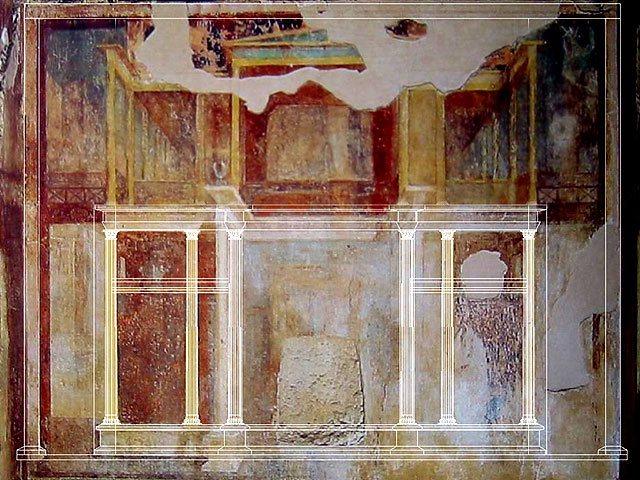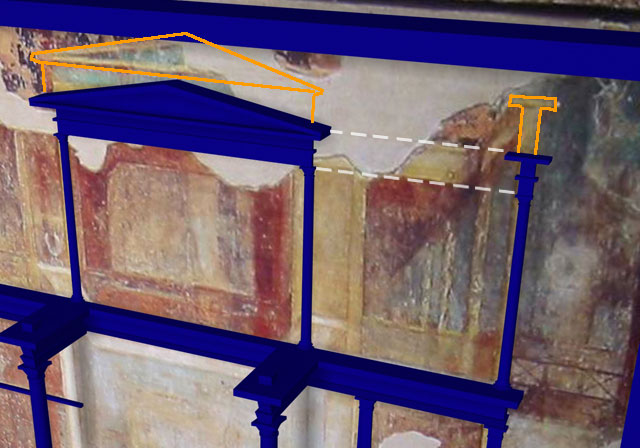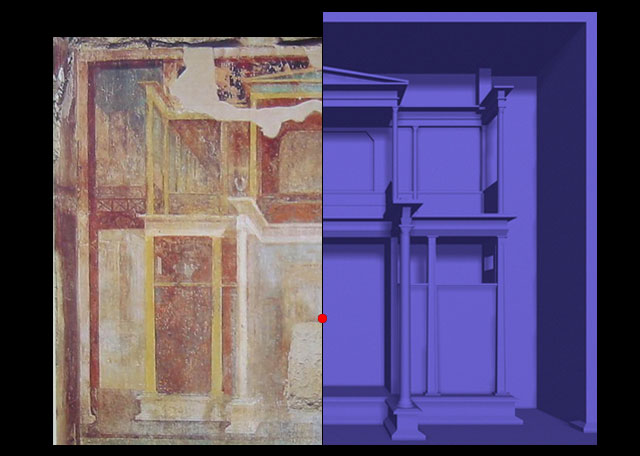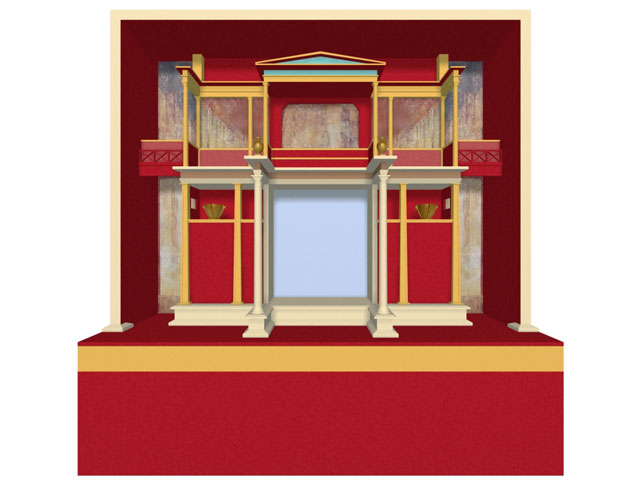The approach to modelling the fresco from the Room of the Perspectival Wall Paintings, described below, has also been used in the case of the Room of the Masks in the House of Augustus, the tablinum in the House of Livia, Room 23 in the Villa at Oplontis, the cubiculum in the House of Pinarius Cerialis, and Room 10 in the House of Siricus.
The objective of the 3d visualisation was to create a structurally-consistent version of the depicted structure.
The 3d model was constructed in 3d Studio Max software by working on top of a photograph of the wall painting, carefully chosen to be distortion free (Figure 1).

Figure 1. Overlay of 3d model onto wall painting.
Notwithstanding the design's almost complete use of a single vanishing point (see perspectival analysis), certain elements are distorted by perspective foreshortening, an example of which, on the upper level, is represented in orange outline in Figure 2 .

Figure 2. Showing construction of the 3d model from the fresco.
The central panel in the lower level was used as the point of reference for estimating the depth and proportions of the rest of the structure, as this area appears unaffected by perspectival foreshortening.
Due to the symmetrical nature of the design, the left and right portions of the structure have been modelled as mirrored copies of each other. This allows for any changes to be made to the model quickly: modifying one side will automatically update the corresponding component on the right side etc. Where sections of the wall painting are damaged or missing on one side, good results to be obtained from using corresponding sections from the other side as the basis for modelling.
As the wall painting only incorporates a single point of perspective, closely resembling a life-like viewpoint, it readily lends itself to comparison with rendered images of a 3d model that also (perforce) represents a single viewpoint. In Figure 3, below, the red dot represents the target position of the virtual camera, which has been placed at the same point as the fresco's own vanishing point.

Figure 3. Comparison of fresco with 3d model viewed with life-like perspective.
The only element of the 3d model that does not correspond with that of the wall painting is the outer frame. As seen in the wall painting, the outer frame appears to have far less depth than that of the 3d model. Whereas a life-like view of the 3d model leaves very little space for the side panels to be seen, the fresco artist has purposefully widened the perspective on the outer frame to allow for a much fuller view of these panels with their painted townscapes.
Basic colour textures were then added to the structure derived from the wall painting, and a light source created, casting soft shadows to resemble the overall appearance depicted in the wall painting. Artefacts seen resting on the architecture were modelled, as were two balconies, bridging the inner structure to the outer frame. (Figure 4).

Figure 4. Final rendering of the 3d model.
The process of creating a 3d model highlights the difficulty, for the modern viewer, of distinguishing between evocations of "real" and "imagined" elements; a problem which the playful idiom of Roman fresco design itself appears to have delighted in posing without resolving.
In the present interpretation, the receding colonnades in the upper level have been treated as painted panels in the 3d model rather than actual architectural elements. The perspectival lines of these "painted" colonnades, however, also clearly match those of the foreground architecture, both emphasizing the impression of a single perspectival system and creating a subtle segue between the real and the imagined. It would be equally valid to treat, and model, the upper and lower colonnades as if designed to evoke "real" architecture.
< back to The House of Augustus contents
